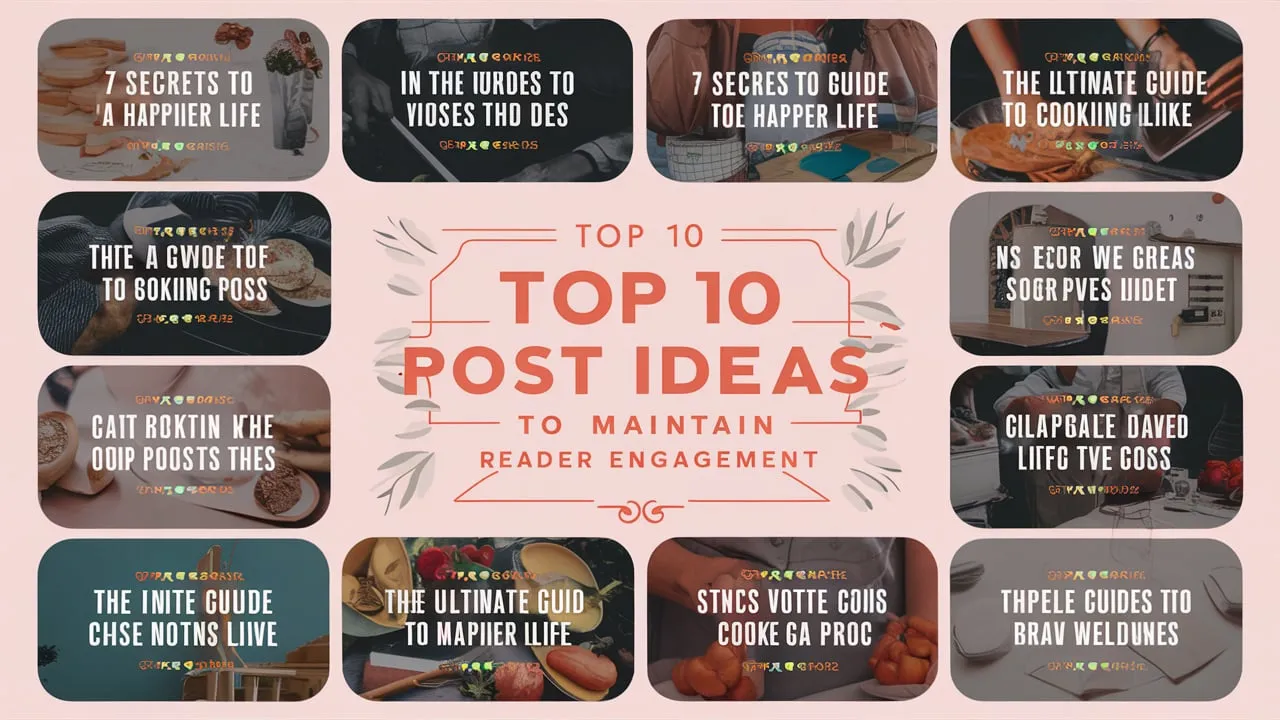Starting a blog is an exciting adventure, but keeping it alive with fresh, engaging content that ranks well on Google? That’s where things can get tricky. It’s not just about writing—it’s about creating value and showing your expertise in a way that keeps both readers and search engines happy. But don’t worry—I’ve got your back. Here are 9 blog post ideas to boost ranking designed to rank high on Google, using smart semantic SEO techniques and the right NLP keywords that Google loves. Let’s get into it!
Table of Contents
1. How-to Guides: The Ultimate Step-by-Step Guide to Boost Your Blog Ranking
People love how-to guides because they solve specific problems in an easy-to-follow manner. A title like “How to Boost Your Online Business on a Shoestring Budget: A Step-by-Step Guide” immediately tells readers what they’ll gain. To make your content rank well, include phrases like “learn how to,” “best methods,” and “step-by-step guide.” Google loves structured, problem-solving content because it provides real value to users. Just be sure to break everything down into simple steps and include helpful visuals.
Pro Tip: Use bullet points or numbered lists to organize steps clearly, which also helps Google identify your content for rich snippets.
2. Listicles: Top 10 Quick, Engaging Blog Post Ideas to Boost Ranking
Listicles are like snacks for the brain—quick, fun, and satisfying. They’re perfect for readers who want the essentials without the fluff. Use catchy titles like “10 Digital Marketing Tools You Can’t Live Without” or “5 Easy Ways to Improve Productivity as a Student-Entrepreneur.” Listicles are easy to scan, and that’s why readers love them. Plus, Google often shows listicles in the featured snippets because of their structured format.
SEO Tip: Keywords like “top tools,” “best ways,” and “must-have” make your listicle stand out in search results. Always ensure your content is engaging, informative, and adds value.
3. Personal Stories: Real Experiences to Boost Blog Engagement
Connecting with readers can most effectively be done through the telling of personal stories. People love authenticity. Sharing what worked, what didn’t, and the lessons you learned helps humanize your brand. For example, write about “How Launching My First Product Failed, and What I Learned from It.” These kinds of posts build trust because you’re not just sharing information; you’re sharing a piece of yourself.
Google Loves This: “In my experience,” and “lessons learned” are phrases that establish authority and experience (key parts of EEAT).
4. Case Studies: Proven Results to Boost Blog Ranking and Increase Traffic
Case studies are powerful. They give your audience proof that your strategies work. A title like “How I Boosted My Online Sales by 200% in 3 Months: A Case Study” not only shares your success but also provides a roadmap for your readers to follow. Case studies show you’re knowledgeable and experienced—Google loves content that demonstrates expertise.
Tip: Use phrases like “real-life example,” “proven results,” and “in-depth analysis” to appeal to Google NLP and build credibility.
5. Reviews: Honest Opinions to Boost Blog Ranking and Build Trust
Reviews are incredibly useful—people rely on them to make decisions. Be honest in your reviews, whether it’s about a product, a book, or a service. Readers value transparency, and Google does too. Titles like “An Honest Review of XYZ Tool: Is It Worth Your Money?” work wonders. Don’t forget to mention if you were gifted a product—readers (and Google) value that transparency.
SEO Keywords: Use terms like “in-depth review,” “honest opinion,” and “is it worth it?” to make your evaluations prominent in search results.
6. Interviews: Expert Insights to Boost Blog Authority and Ranking
Interviews boost your blog’s freshness by bringing new angles. Speaking with pros gives you access to their wisdom and their followers. For instance, “Digital Marketing Pro Shares Success Tips for 2024,” offers vital knowledge your readers might not discover anywhere else. Interviews transform your blog into a main hangout for expert views and trusted info.
Bonus Tip: Use phrases like “expert insights,” “industry leaders,” and “exclusive interview” to rank well and show your blog as a trusted source of information.
7. Guest Posts: Fresh Voices to Boost Blog Traffic and Ranking
Guest posts can breathe new life into your blog. Inviting others to contribute helps diversify your content and expand your reach because your guest authors will share their posts with their own audiences. Posts like “Guest Post: 5 Tips to Master Freelance Writing by Jane Doe” can help you connect with new readers and boost your domain authority.
SEO Bonus: Guest posts often come with backlinks, which are crucial for building domain authority and improving your Google ranking.
8. FAQs: Answer Your Audience’s Burning Questions to Boost Blog SEO
FAQs are fantastic for addressing the questions your audience is already asking. For instance, a post titled “FAQs About Starting an Online Business” can attract readers searching for specific answers. FAQs tend to rank well because they directly address the queries people type into search bars. Google loves posts that answer specific questions clearly and concisely.
Google Loves This: Keywords like “how do I,” “what is the best way,” and “why should I” are great for ranking in rich snippets and increasing your blog’s visibility.
9. Behind-the-Scenes Content: Humanize Your Brand to Boost Engagement and Ranking
Letting your readers peek behind the curtain helps build a connection with them. Whether it’s “A Day in the Life of an Entrepreneur” or “How We Create Our Products from Scratch,” behind-the-scenes posts make your brand relatable and authentic. People love to see the human side of businesses, and this type of content can turn casual readers into loyal followers.
EEAT Focus: Use phrases like “how we do it,” “behind the scenes,” and “our process” to convey transparency and authenticity, both of which help with Google’s EEAT standards.
Final Thoughts: Start Ranking Higher by Connecting with Your Audience
Writing interesting stuff shouldn’t seem tough. All you need is to concentrate on 9 types of blog posts. Use SEO semantics and Google NLP keywords too! This way, you’ll help your blog climb higher in search ranks and be seen more. Plus, your readers will really like what they read! Just remember: be real, full of info, and fun. Show off your skills and be the boss!
Don’t forget: EEAT—Expertise, Experience, Authority, and Trustworthiness—is key. Continue sharing useful information, stay authentic, and see your blog transform into a reliable resource that ranks high on Google.
Happy blogging! Which kind of blog post do you enjoy creating most? Let me know in the comments!







3 thoughts on “Boost Your Blog Ranking with These Top 9 Proven Blog Post Ideas to Rank #1 on Google”
Comments are closed.